After making us wait for a decade, Sanjay Leela Bhansali comes up with his magnum opus Bajirao Mastani. Based on the book Rau by N.S. Inamdar, it is the story of the romance of a Marathi king Bajirao (Ranveer Singh) with a Muslim warrior princess Mastani (Deepika Padukone) even though he is married to Kashibai (Priyanka Chopra). In Bhansali land, love brings exhilaration, but also pain, and longing. In his earlier films, such as Hum Dil De Chuke Sanam, Devdas, Saawariya, Ram-Leela, and in Bajirao Mastani, as well, love brings with itself joy, heartbreak, suffering, anguish, and grief. It is a story of an ishq that makes one forget even God in front of the lover. Ishq—Jo mehboob ko dekhe toh khuda ko bhool jaaye, vo ishq. Love is like a scar, ugly and forbidden in the eyes of the society but permanent that would endure the test of time and become immortal in the annals of history. At one point, Mastani literally scars Bajirao with her sword in his neck, and that scar is visible later, etched on him in perpetuity. Later, Bajirao wounds her in the war with his sword. Aapne to sirf apne vaar ka nishaan dekha hai, ghaav to kahi aur hai. They are literally and metaphorically scarred for life by love.

In many ways, the film is the story of Radha, Krishna, and Rukmini. In Bhansali’s world, Bajirao and Mastani are Krishna and Radha. The film is full of references to these characters. Mastani says, “Patni to Radha bhi nahi thi, lekin naam to Krishna ke saath unhi ka liya jata hai na.” When they celebrate Holi, Mastani sings, “Mohe rang do laal, Nand ke laal laal,” exhorting Nand Ke Laal Krishna to paint her in the color of love—red. During Pinga, when Mastani comes to meet Kashibai, the subtitles read that she comes dressed as Radha giving one more indication of the Radha-Krishna theme. One of my favorite scenes from the movie Lagaan is the Janmasthmi one, when Elizabeth asks Bhuvan if Radha and Krishna were married to each other. Bhuvan replies that Krishna was married to Rukmini, and Radha was married to Anay, but they had this internal love that transcended generations. Kamal ke patte pe, shabnam ki boond jaisa. Ek bhi nahi hue aur alag bhi nahi hue. It was the first time that I ever got to know the name of Krishna’s wife and more importantly, Radha’s husband. Since times immemorial, Radha-Krishna have been the epitome of pure love. While Anay seems to have been discarded permanently from the annals of mythology, Rukmini gets a mention sometimes. With Bajirao and Mastani as Krishna and Radha, the film acknowledges the silent, and the almost forgotten love of Rukmini in the form of Kashibai. Kashibai narrates the story of Rukmini’s trepidation on the fear of being forgotten. Log toh priyasi ko hi yaad rakhte hain. Even though the film is based on Bajirao and Mastani, Kashibai’s love is acknowledged, even if it takes some sheen off the leads’ story, I feel it is important to give her due, because a film based on the theme of love, should be graceful enough to accept all kinds of love or at the very least not be dismissive about it. Kiran Nagarkar’s gem of a book Cuckold, based on the predication of Meerabai’s husband whose wife is in love with Lord Krishna, says one can exorcise a devil, but how does one get rid of a God. There is a line in that book. “We were that rarest of couples. Even after years of marriage we were madly in love. I with her and she with somebody else.” This could very well be Kashibai speaking.
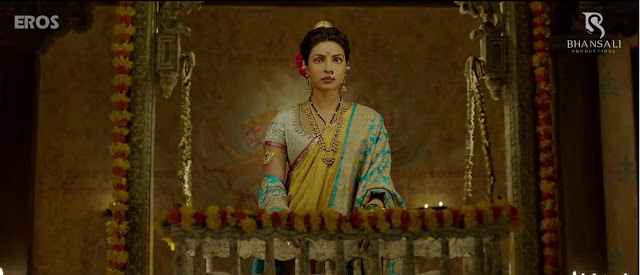

In some ways, Bajirao Mastani also depicts the seven stages of love as defined in Arabic literature. The seven stages comprise hub (attraction), uns (infatuation), ishq (love), aqeedat (reverence), ibaadat (worship), junoon (obsession), and maut (death). We see these stages in some form or the other. The first time Bajirao and Mastani get attracted to each other in the middle of the war. Behoshi me bhi aap unse aise lipti hui thi, jaise do nahi ek ho. Then, there is infatuation when he visits her in her chambers, and he gives his dagger to her after looking at her deep wounds. They celebrate Holi. She tells him to paint her in the color of love. This infatuation turns into love when he is about to leave. She then leaves Bundelkhand because of ishq to meet him. Her love for him is like Radha’s love for Krishna. Patni to Radha bhi nahi thi, lekin naam to Krishna ke saath unhi ka liya jata hai na. This ishq turns to reverence. Tujhe yaad kar liya hai, aayat ki tarah, kaayam tu ho gayi hai, rivaayat ki tarah. I have memorized you, like an aayat, a holy prayer. For me, you have now become a custom and a ritual. They both start trusting and respecting each other; he will fight for her respect even it means to go against the world, he will go against his family to protect her honor. This slowly becomes into an ibaadat. Aaj ibaadat roobaroo ho gayi, jo maangi thi us dua se guftgoo ho gayi. The one for whom I have worshipped and prayed for, I’ve come face to face with her today. What I was desiring for, I’ve had a conversation with her. Slowly, this ibaadat turns into an obsession for them. She cannot live without him, and neither can he. Humare dil ek saath dhadhakte hai aur rukte bhi ek saath. He is ready to give up anything for her, and she will do anything to be with him. In the process, they lose their own identity. In the final stages, Bajirao’s junoon becomes hallucinations where he sees fate and destiny conspiring against him and Mastani. He fights an imaginary war with his inner faceless demons. Death is the only escape from this madness, and it comes to them at the same time. The final stage of love is achieved and they are immortalized for the years to come and everyone will take their name together as one. They have been united forever.

The film is spectacular in showing the glorious tradition of the past. When Bajirao gives a dagger to Mastani, she becomes his wife as giving a kataar to a woman also meant marriage in Bundelkhand. Later, when Bajirao comes to visit Mastani after crossing the river, he talks about the three challenges that she could face if he accepts her. Mastani, without any iota of hesitation, says kubool hai. In an Islamic wedding, the bride says kubool hai three times; in a way, it was the second time that they got married. In both the cases, there was no big ceremony, and their wedding got solemnized based on tradition and customs. At the onset, Bajirao talks about creating a Hindu kingdom giving indications of his Hindu nationalist leanings. While there is tradition in the film, it also surprises us with its liberalism. Mastani worships both Krishna and Allah. Even though she is a Muslim, she names her child Krishna. Yeh sach hai har dharm ne ek rang ko chun liya hai, lekin rang ka to koi dharm nahi hota. Durga and dargah might belong to different religions but at the same time, the same green color is important for both of them. Bajirao says even though he fights Muslims, his fight is with Mughals, not with their religion. He names his son Shamsher Bahadur in defiance when the fundamentalist priests refuse to do a naming ceremony for his son Krishna accusing him of not marrying a woman according to Hindu rituals. He teaches both his sons the shlokas. Rather than giving into dogmatic rituals, he makes new interpretations of them, like the cracker of a reply he gives to his heartless mother—what kind of mother stops her own grandson from taking her blessings—that he will make amends by marrying Mastani with full celebrations and bring her to Shaniwar Wada. Earlier this year, Zoya Akhtar’s Dil Dhadhakne Do had an insightful scene. That film also starred Ranveer Singh; at one point, he says to his parents that he loves Farah. Vo dancer hai, aur Musalman hai. Religion continues to be one of our society’s deepest fault-line that a film set nearly three hundred years later in an upper class tony family of Delhi has undercurrents of the same religious difference in a film of the past. In this political climate, when we are debating ghar waapsi, it is heartening to see that the film holds onto its liberalism.
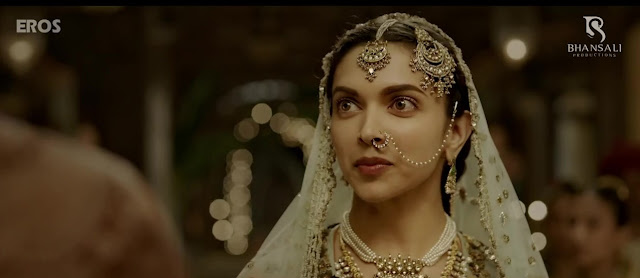
Any Sanjay Leela Bhansali film is a study in symbolism. The sets and the costumes represent the characters and their emotions. Cheeteh ki chaal, baaz ki nazar aur Bajirao ki talvar par sandeh nahi karte, kabhi bhi maat de sakti hai. Therefore, everywhere we see the images and the statues of the cheetah and the baaz. When Bajirao is in his camp, there are bronze carvings of the eagle and the cheetah. The map and the flag of the kingdom have the eagle and the cheetah in it. In Shaniwar Wada, his room has the same images and statues. Even Bajirao’s dagger, the one that he gives to Mastani, has a cheetah on its end. This reinforces the idea that not only Bajirao was skilled in sword-fighting, but had these other two qualities—a remarkable celerity, and a razor-sharp vision. If Bajirao was a cheetah, Mastani was a lioness in the jungle. When a lioness gives birth, there are no midwives and nurses, likewise, Mastani does not require any help, and gives birth to her son without the services of a midwife.
The map has cheetah and baaz
The costumes, too, told us about the characters. Mastani is always dressed in lighter colors, with the only exception of red. All her costumes had a single-colored palette, and had lighter shades. Whether it is the Deewani Mastani song, the blue lehengas, the yellow lehengas, the white lehengas, everything seems to be in lighter shades, and they do not have a contrasting color in them. On the other hand, Kashibai’s sarees are full of dark colors, and they are not single-colored, but have many, many colors in them, such as a contrast of purple, blue, yellow, and much brighter than Mastani’s. It is an indication of the many worldly emotions of Kashibai from love, happiness, joy, fear, while Mastani is only interested in the one emotion of love and red signifies that love.
At another instant, Kashibai tells Bajirao to not come into her chambers anymore, she is trying to light off the diyas. She cannot reach the height, so, Bajirao takes the stick and puts them off, just like their relationship that seems to have to run its course.
In Bundelkhand, when Bajirao is to leave the next day, Mastani visits him in the middle of the night and gives a paan to him. When Mastani comes to Shaniwar Wada, after she sings Deewani Mastani, Bajirao welcomes her by giving paan. The betel leaf has been a part of Hindu tradition for a long time, even shown in some miniature paintings depicting Krishna offering paan beeda to Radha. There is an amorous quality associated in giving a heart-shaped leaf to one’s lover; perhaps, that is why paan continues to be romanticized in films. At a later point, Kashibai also gives a paan to Bajirao when he visits her when she tells him she is pregnant. The way she gives the paan to him was an indication that she saw that he had given Mastani the paan. He thinks that she does not know anything, but she is smart and intuitive. She says, “Yeh chaand bhi na kabhi is badli ke peeche, kabhi us badli ke peeche,” with the reference of the moon to Bajirao’s hidden relationship with Mastani.

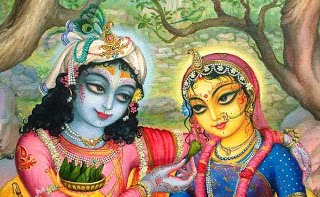
One of my favorite scenes in the film is when Kashibai and Bajirao’s mother are sewing the flag, and talking how they are similar to each other. Kashibai says that all through the years, she was Bajirao’s parchhai and without telling, he went into darkness. In darkness, a shadow does not exist, making her question her own existence. In that scene, we see her image in the mirror in a box near to her. It is a lovely scene, and her image is clearly seen even in the darkness of the room. The image is a classic trope in Bhansali’s films. In a gorgeous scene in Saawariya, Sakina’s image is projected in the mirrors. In Goliyon Ki Raas Leela Ram-Leela, Leela’s image is seen in a mirror. Early in the film, Mastani is seen holding a rose in front of a mirror. One of the most aesthetic scenes in the film involve Bajirao’s image projected on a mirror. Thereafter, Maa Saheb compares their lives to a mango tree; even though mango might be the king of fruits, but it is the one that has to bear the most stones. Perhaps, Maa Saheb used this as a reference to her own husband’s infidelity during his life, or maybe she misses the presence of her husband in her life, and can understand Kashi’s plight. The two of them were bonding by sewing a saffron flag—the flag of their kingdom—as if they are bound together by tradition, and their helplessness to change the nature of their relationships. In the process, they ‘sew’ a bond with each other. In Saawariya, Sakina used to weave carpets. One welcomes the other by putting the best carpet. Sakina kept waiting for Imaan and wove the finest kaaleen to welcome him in her heart. Here, we see two women talk about relationships while sewing a flag.




Love is the permanent state of intoxication for Bajirao and Mastani. Mastani’s eyes flow with love for Bajirao; the moment after she falls in love with Bajirao till the end, her eyes seem watery as if she is intoxicated by love. In the same way, Bajirao, too, is inebriated in her love. At one point, he even says, “Kaun nashe me nahi hai? Hum sab nashe me hai.” Bajirao’s eyes are seen to have a red blood color lining. Their love is so strong that she is flowing in his body like blood. He cannot exist without her, neither can she. Without blood, no human can survive. The red color that symbolizes Mastani is deeply ingrained in his veins. Even the title poster shows that the red colour is in Bajirao’s name.

Nature and its elements are a significant part of Bhansali’s oeuvre. In Hum Dil De Chuke Sanam, Nandini is depicted as the finest creation of nature in Manmohini Tera Ada. Tujh me hai kudrat saree khoyee khoyee. In Black, Michelle McNelly’s first words are not mother or father, but water. It was a new birth of her where she was immersed in the water at the fountain. In Bajirao Mastani, too, nature is a character in itself. The sky changes its color depending upon the mood. When Mastani sings Mohe Rang Do Laal with her gulaal hands, the sky turns red. When Mastani is welcomed for the first time by Kashibai, the sky seems to be changing color from grey to red. When there is death, it rains as if the sky is crying.

Water, too, plays an important part in Bajirao’s life. He crosses a river going wild, in the middle of a stormy night, to meet Mastani. He is seen walking in the water many a time. When he calls upon the Nizam, he walks through the water. When he visits Mastani, he is standing in water, surrounded by lovely fountains, and calls her to join him. Later, Kashibai invites him in the water; however, there are no fountains, because his fountain of love is now for Mastani. In the final scene, death comes to Bajirao in water. Perhaps, water represents the purity of his thoughts, his actions, his intentions, and his love. In Black, water represented purity and clarity of thought that helps Michelle realize that words have a meaning. In that film, too, fountain formed an important part. Michelle’s first word is spoken by her in the water at a fountain; in the end, Debraj also learns his first word ‘water’ from Michelle near a fountain. The magnificent poster of the film depicts Bajirao and Mastani standing in water, surrounded by lotuses, with tiny streams of water beneath and behind them. They are holding hands; perhaps, their love is like a fountain itself, sustaining them like the fountain of life.

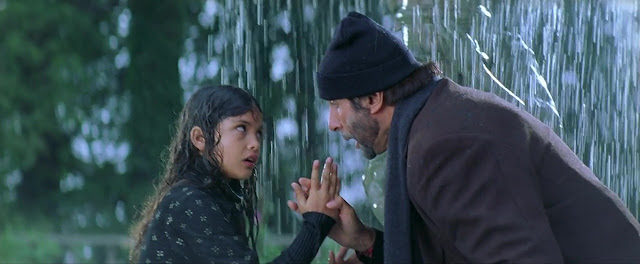
If there is sky and water, fire would catch up soon. There is fire in almost every scene in the film. Mastani uses the fire to light her arrow, Kashibai uses the fire to glow the diyas, Bajirao uses fire to stop the zeher of the wound he inflicted from spreading in Mastani’s body. This fire is also a subtext for the burning passion of the characters. One of the most beautiful scenes in the movie is when Kashibai is sitting over a golden statue of a cheetah-lion hybrid, with fire burning in front of her. This fire is her state of mind, burning with desire for Bajirao as Mastani seems to have become the object of her husband’s affection. In an earlier scene, Bajirao pours water over Kashibai. Dressed in a saffron saree, a color that matches the color of the fire, this pouring of water was, perhaps, a subtle indication that the fire that Kashibai ignited in Bajirao’s heart is starting to extinguish. It is Mastani who now ignites the fire in him. However, Kashibai’s heart still beats for him, and sitting on the animal statue, which was a reference to Bajirao himself.

And, then there is the nature itself. Bajirao wears a
navgriha ring, made up of the nine planets.
Yeh dharti, yeh aasman, yeh toofaan, aur yeh seene ki aag ko sakshi manke, aaj se hum aap ko apni patni maante hai. The nature—the earth, the sky, the wind, the water, and the fire in his heart—becomes the sole witness to their communion. It is as if nature has blessed them. In the end, he says that they will meet the next time when the sky will have the setting sun, and the rising moon; that day, the sky will change its colors; the winds of desire will be blowing; the clouds will be thundering; the dry leaves will be swishing; and, there will be an untimely rain. There will be no barriers of religion, no earthly relationships, there will be only fire, the fire of their love. It is again the nature and its elements that provide the conditions for their eternal union. Bajirao might have won forty wars, but he couldn’t win the one that he fought for Mastani. It is only in death, that they will be able to meet forever.
Sanjay Leela Bhansali is in love with the peacocks. Ram-Leela was full of peacocks. Every song of that film had a peacock reference, and Ram was compared to a peacock in the film. Even Hum Dil De Chuke Sanam was teeming with peacocks. His love for peacocks is immense that even the symbol of Bhansali Productions is a peacock. Expectedly, Bajirao Mastani has peacock references. There is not only a peacock feather, but patterns of peacock feathers in the palace walls and the floors, the diyas, the earrings, and the lamps. When Mastani is sent to live in the red light area, a woman jokingly calls her a morni. When she visits Mastani Mahal for the first time, we can hear a peacock screaming in the background. There are also many lotuses in the film. When Bajirao visits the Aaina Mahal, Chimaji tells him he is standing on a lotus. There are lotus flowers in Kashibai’s and Mastani’s rooms. Even the film’s gorgeous poster is teeming with flowing pink lotuses. The song Aaj Ibaadat says, “Om Jai Jai Om, mangalam pundarikaaksham manglaaye tano Hari.” All auspiciousness to the one who has eyes like petals of a lotus flower. And auspiciousness to Krishna. Krishna is associated with peacocks, and lotuses; not only do they add to the Krishna reference, but the presence of these symbols also underscore the spiritual and divine elements in his earlier films as well as in Bajirao Mastani. His heroes and heroines are embodiment of gods and goddesses.

Lotus
Each frame of the film is so exquisite that one cannot help but marvel at this painting. It is truly like poetry in motion. The film stuns with its visual resplendence. At so many points, I was just smiling to myself, and thinking about its brilliance. One can’t help but be mesmerized by it. When that scene comes where they project Bajirao’s image in Kashibai’s room, and later, it is the similar sequence when Kashibai sees Bajirao and Mastani together—what a thought, what a scene. The top shots, another signature elements of his films, are breathtaking. The symmetrical top shot of the priests eating from green leaves, the shot of women dressed in red at Mastani’s father’s place in preparation of the pyre, the Gajanan song sequence, even the way that the peacock logo of his production house is made in the title credits using gulaal is marvelous.
Like any Bhansali film, all the songs are splendidly choreographed. The song Deewani Mastani is a dream song on the big screen. Its beauty is unparalleled. I was waiting for this song to come. Just the top shots of the song are worth the price of the film’s ticket. The song is a glorious homage to one of the most iconic songs of Hindi cinema—Jab Pyar Kiya Toh Darna Kya from Mughal-E-Azam. Madhubala, dancing in front of the emperor of India, declared her love for Salim in complete defiance of the world. At one point in the song, she sings, “Chhup na sakega ishq hamara, chaaron taraf hai unka nazaara.” Her images are then reflected across the mirror walls of the palace. She is everywhere. Mastani enters the Shaniwar Wada for the first time. She comes dressed in a golden lehenga, wearing a golden Peshwa topi and a golden nose ring, holding an intricately carved golden mandolin. The golden color matches the walls of the palace. There is a special significance of the golden color, and the matching of the color of her dress and the color of the palace. A palace signifies something strong, grand, and brave. Mastani shares these characteristics with the palace. Her story will stand the test of time, like the walls of palace are a testament to this era. She sings, “Mashoor mere ishq ki kahani ho gayi. Kehte hai yeh deewani mastani ho gayi.” Her love story has become famous, and she has become mad in love. And, this story of hers will be written in ‘golden’ letters in the annals of history. As they say, itihaas ke sunehre aksharon me likha jayega. Like Anaarkali, she defied the orders of Maa Saheb, and comes to meet Bajirao. As Anarkali’s love was everywhere in the walls of Aina Mahal, so is Mastani everywhere in the palace. The palace will be a testimony to her timelessness. Her sillage will linger in the walls of the palace for generations to come. Perhaps, that explains the amalgamation of Mastani and the palace in the song. In numerous interviews, Sanjay Leela Bhansali has said that when ever he makes a film for posterity. His characters are destined for posterity, too.
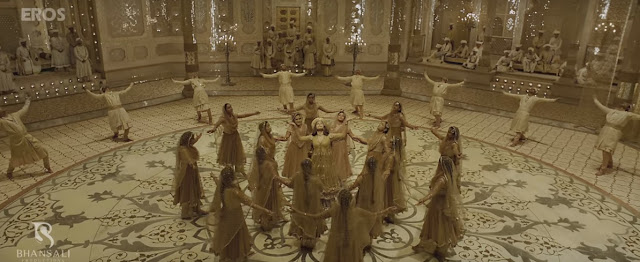
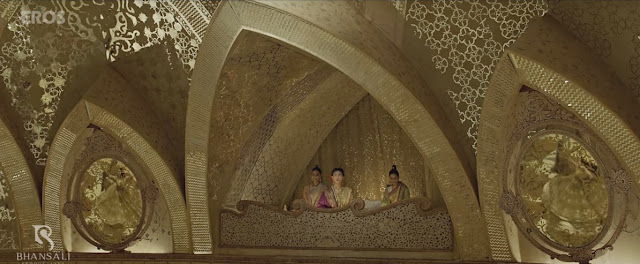
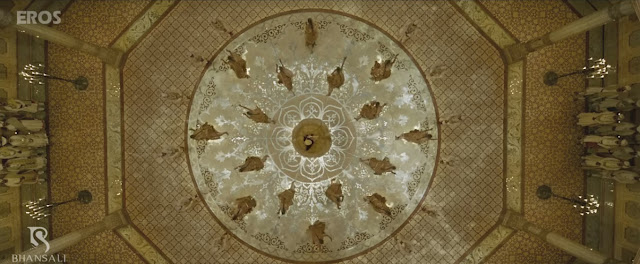
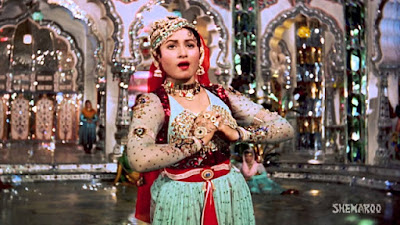
In Devdas, Paro and Chandramukhi, the two women who loved the same man, had danced together on Dola Re. In Bajirao Mastani, it is the two wives of Bajirao who dance together in Pinga. Kashibai and Mastani are dressed in a traditional Marathi silk saree, with a traditional necklace, a khopa hairdo and green bangles. The only difference between them seems to the color of the saree. While Kashibai is wearing a purple one, Mastani is wearing a dark-red one. This contrast symbolizes the personalities of these two women. Kashibai is royal and regal. The color purple is symbolic of power, wisdom, leadership, respect, and wealth. It has been worn by emperors in the past. Even in the song, Deewani Mastani and the film’s poster, Kashibai is dressed in purple hues. In fact, Kashibai always carried a purple stroll with her. On the other hand, Mastani, true to her name, is dressed in dark-red, as red is a color of passion and determination. At one point in the song, she sings, “Haan tu jaane yeh duniyadari, main to hu bas mohabbat ki maari.” She does not care of the worldly stuff, she is only immersed in her divine love. Pakeezah hasti hai teri, tu noorani hai. There is another moment in the song, when Mastani sits in front of Kashibai, which reflects her lower stature as the second wife. This similitude in the costumes points that both of them love the same man. Both of them share the love for and by Bajirao, with changes in color underscoring the difference in their personalities. In fact, at one point, they even sing, “Jo peer meri hai so peer teri hai.” What I worship, you worship it, too. In Dola Re, Paro and Chandramukhi dressed almost identical with no difference even in the colors, which reflected the shared love for the same man. At one point in that song, Paro advises Chandramukhi to put sindur, and gestures a movement where she puts sindur in Chandramukhi’s maang, and then puts it in her own head, pointing that they both love the same man, although they don’t know it. Here, they sing, “Are dono ki maang laage, sooni aadhi, aadhi laal.” Like their half-filled maang, they share the half love of a man who can never be completely theirs. It is a beautiful thought.
Not only
Deewani Mastani, but the beautiful song
Mohe Rang Do Laal is also inspired from
Mohe Panghat Pe Nand Laal from
Mughal-E-Azam. In that song, Anarkali playing Radha sings, “
Mori najuk kalaiyaa marod gayo re.” Here, Mastani sings, “
Marodi kalaai mori.” The similarity of lyrics, the presence of the fountains, the sitting women playing
veena, and the audience comprising the dancer’s would be lover in the two songs leave no room of doubt that this is a tribute to
Mughal-E-Azam. In addition, the scene where Mastani is in chains is reminiscent of Anarkali in chains. The
thumri that plays in the background when Bajirao and Kashibai are engaged in coitus also seems to have been inspired from
Mughal-E-Azam. Even in
Mughal-E-Azam, Anarkali danced on the floors with lotus paintings, like here. “
Mohabbat jo darti hai, vo mohabbat nahi aiyyashi hai,” said Salim; “
Bajirao ne Mastani se mohabbat ki hai, aiyyashi nahi,” said Bajirao. In many interviews, Bhansali has said that
Mughal-E-Azam is his favorite film. He used to watch it with his father every year when he was growing up. Even in
Saawariya, Imaan, Sakina and Badi Ammi watch
Mughal-E-Azam and Badi Ammi remembers all the dialogues from that film. With
Bajirao Mastani, he reinforces the immense love that he has for that film.
Albela Sajan that was also in Hum Dil De Chuke Sanam, is recreated in Bajirao Mastani, and is a delightful classical composition. I also very much enjoyed Malhari despite the criticism that was hurled at it. It is a totally energetic and infectious song. My biggest disappointment was the song I liked the most, Ab Tohe Jane Na Dungi, was not there in the film. The background score comprising Ji Re Ji Re is such enthralling, that it lifts up the scene by a few notches. I wish they release that as a track, too.
Ranveer Singh as Bajirao delivers a stupendous performance. The way he walks, the way he speaks, the way he shows his aggression, he brings the gravitas required for the role. Bajirao says Mastani was his
prerna, and Kashi was his
taakat. He knows that maintaining relationships are more difficult than making relationships. He stops meeting Mastani because he wanted to tell Kashi about his relationship with Mastani first because she was his friend and confidant, and respects his relationship with her. The film enters into an interesting territory when Mastani says to Kashi that if he held her hand, he did not let go of Kashi’s either. Can one can be in love with two women at the same time? There is no doubt that he loved Mastani, maybe even more than Kashi, but did he stop loving Kashi? I have always wondered if human beings are destined to be monogamous. I think one can be in love with two people at the same time, perhaps the intensity for love might vary. For instance, take a film such as
Kal Ho Naa Ho. Naina is in love with Aman, but she gets married to Rohit. Aman was her first love, and she says that she will always remember him. Aman died, but she never stopped caring for him. What if Amar did not die? Would she stop loving Aman? Coming back, when Bajirao is sick, he asks about Mastani, but he also asks about Kashi. He never forgets her. Or maybe love dissipated and she turned more into a friend.

Deepika as Mastani looks ravishing. One can imagine her to be the woman Mastani was, but somehow, her passion got slightly subdued in the second half. Without a doubt, she was the most intriguing character. The first time, we see her, she comes to ask for help from Bajirao to save her kingdom. Later, she even fights the war with him. Why does her father not go into the war with her? She is the one fighting the battle to save her kingdom putting her life in danger. Moreover, she was not even the legitimate heir to her father as Mastani’s mother never married her father. That made me think if that drove her desire to be accepted by Bajirao’s family. Bajirao had told her that she will be humiliated forever if she marries him, and she gladly accepted. Maybe that was another reason she never rebelled against his family. She accepted to live in the house of a prostitute, and even stays in a khandar. Love makes her lose her identity. There is a fascinating scene where she is sent to the prostitute house. She takes out her sword and practices with it. Perhaps, that was her way of channeling out her anger. Something violent in its conception can be therapeutic for her. Love also brings a certain intuitive and a magical power. I really liked how she could sense that Bajirao was coming to meet her. Even in the climax, she can sense that something is not right.
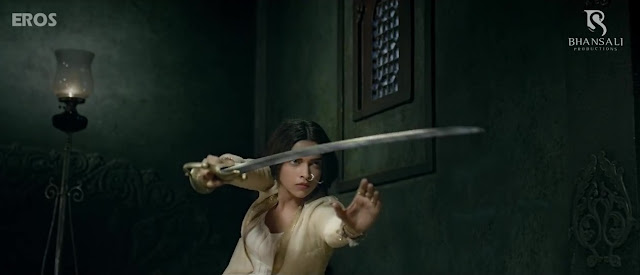
My most favorite character was that of Kashibai. It is a very well-written character, and Priyanka Chopra flies with it. She stole the show from everyone. She accepted the role knowing it is not the lead one, and still managed to get all the accolades. She stars in an international TV show, brings out her own album, and shines in any role. Priyanka, you go girl. The character of Kashibai was inpsired by Raja Ravi Varma paintings. At one point, when she is sitting and crying in her chambers, with the white swan, that scene is a replica of a Raja Ravi Varma painting. Kashibai was the wronged one, we sympathize with her, but we don’t pity her. She does not become desperate or vengeful, boiling for Mastani’s blood. In fact, she does not even care for paraye people when Bajirao said that he and Mastani must have hurt her. She was more hurt by the wounds inflicted by apne. She never loses her self-respect, but at the same time, is able to convey that she is hurt. She wishes that she was the beloved than the wife because a wife is forgotten and history remembers the preyasi. Still, she goes upon doing her duties as a wife. She will welcome Mastani in her palace, but not in her heart. She never loses her humanism, when she could have easily got Mastani killed when she got to know that there is an attack planned on Mastani. But she goes and conveys to Bajirao about the impending attack. That scene spoke volumes about the strength of her character. Eventually, she goes and meets Mastani in her palace. She makes some hurtful comments to her, but then also realizes that since Mastani is special to her husband, she has to to come around. Rao ko tumhari zaroorat hai, aur unki zaroorat ka khayal rakhna hamari zaroorat hai. The sacrifice of the wronged lover is a repeating trope in Bhansali’s work, and somehow, this wronged lover triumphs by the strength of his character. Be it Vanraj, Chandramukhi, Gulaab ji, or Kashibai. These characters understand love much more deeply, because to them love lies in the happiness of the lover even if it brings pain to them. As Nandini said, “Tumne mujhe pyaar karna sikhaya, magar pyaar nibhaana maine apne pati se seekha hai.” Kashibai knew the real meaning of love, and comes out as the bigger person in the end. Rukmini may or may not be forgotten, but Kashibai will live forever.
At many instances, I was reminded of Jodhaa Akbar. For instance, at one point, Kashibai is watching Bajirao taking a bath. In Jodhaa Akbar, Jodhaa watches Akbar practising his sword, and he tries to entice her to keep looking at him. When Mastani says, “Adhuri mulakat hi to phir se milne ka vaada hota hai”, I was somehow reminded of Kabhi Alvida Naa Kehna where Dev says, “Alvida nahi, alvida kehne se phir milne ki ummeed mar jaati hai, kya pata phir mile.”
It was a bit disheartening to see the largest ever disclaimer that was put in the movie that this is a work of fiction. I am amused by the protests and criticism that it is trying to distort history. Do people really believe that Akbar’s son was Salim as shown in Mughal-E-Azam? It was a work of fiction. There was opprobrium that he made Paro and Chandramukhi dance together in Devdas. Devdas was itself a work of fiction, so, is it a crime to interpret a story in one’s own way? Aren’t there nearly three hundred versions of Ramayana?
In an interview with Anupama Chopra, Sanjay revealed that the reason he makes grand sets is to ward off his childhood claustrophobia. His sets are a mélange of the emotions of his characters. There is so much happening in the movie that one viewing is simply not enough to capture all the details. I remember reading a few pieces when Avatar had released. Critics had praised it as the movie that took people back to the theaters for it made people rediscover the experience of watching the movie on the big screen. Even though Hindi cinema has always been larger than life, Sanjay Leela Bhansali is one of those few filmmakers whose films seem to have a magical hold on the big screen. Bajirao Mastani is a film that needs to be experienced on the big screen. Bajirao Mastani is the fulfillment of a lifelong dream for Sanjay Leela Bhansali. A character in the movie says, “Chandan ke vriksh ko bhi sugandh dene kiye ek umar ki aavashakta hoti hai.” A sandalwood tree takes more than a decade before it is harvested for its fragrance. Strange are the things how life works. It took more than a decade to make this film. Maybe it is destiny, where the cosmos conspires to find the right time. As chandan‘s fragrance lasts forever, the fragrance of the movie will continue to enthral in the coming future.
[Read more of the author’s work on his
blog here]










































Leave A Comment
You must be logged in to post a comment.